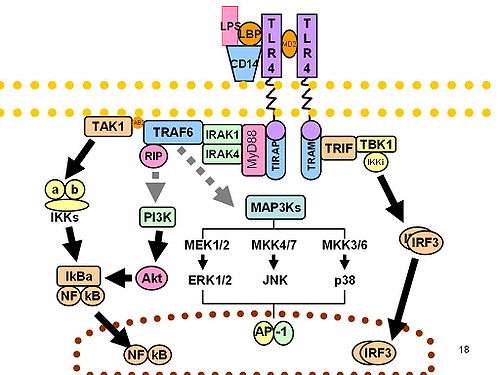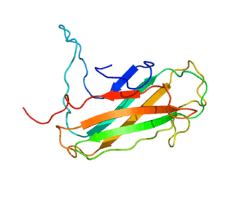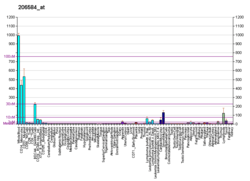Lymphocyte antigen 96
Lymphocyte antigen 96, also known as "Myeloid Differentiation factor 2 (MD-2)," is a protein that in humans is encoded by the LY96 gene.[5][6][7][8]
The protein encoded by this gene is involved in binding lipopolysaccharide with Toll-Like Receptor (TLR4).
Function
The MD-2 protein appears to associate with toll-like receptor 4 on the cell surface and confers responsiveness to lipopolysaccharide (LPS), thus providing a link between the receptor and LPS signaling.[7] That is, the primary interface between TLR4 and MD-2 is formed before binding LPS and the dimerization interface is induced by binding LPS.[8]
Structure
MD-2 has a β-cup fold structure composed of two anti-parallel β sheets forming a large hydrophobic pocket for ligand binding.[9][10]
Interactions
Lymphocyte antigen 96 has been shown to interact with TLR 4.[5][11]
When LPS binds to a hydrophobic pocket in MD-2, it directly mediates dimerization of the two TLR4-MD-2 complexes. Thus, MD-2 form a heterodimer that recognizes a common pattern in structurally diverse LPS molecules. These interactions allow TLR4 to recognize LPS.[8]
LPS is extracted from the bacterial membrane and transferred to TLR4-MD-2 by two accessory proteins, LPS-binding protein and CD14, to induce innate immune response.[8]
References
- GRCh38: Ensembl release 89: ENSG00000154589 - Ensembl, May 2017
- GRCm38: Ensembl release 89: ENSMUSG00000025779 - Ensembl, May 2017
- "Human PubMed Reference:". National Center for Biotechnology Information, U.S. National Library of Medicine.
- "Mouse PubMed Reference:". National Center for Biotechnology Information, U.S. National Library of Medicine.
- Shimazu R, Akashi S, Ogata H, Nagai Y, Fukudome K, Miyake K, Kimoto M (June 1999). "MD-2, a molecule that confers lipopolysaccharide responsiveness on Toll-like receptor 4". The Journal of Experimental Medicine. 189 (11): 1777–82. doi:10.1084/jem.189.11.1777. PMC 2193086. PMID 10359581.
- Abreu MT, Vora P, Faure E, Thomas LS, Arnold ET, Arditi M (August 2001). "Decreased expression of Toll-like receptor-4 and MD-2 correlates with intestinal epithelial cell protection against dysregulated proinflammatory gene expression in response to bacterial lipopolysaccharide". Journal of Immunology. 167 (3): 1609–16. doi:10.4049/jimmunol.167.3.1609. PMID 11466383.
- "Entrez Gene: LY96 lymphocyte antigen 96".
- Park BS, Song DH, Kim HM, Choi BS, Lee H, Lee JO (April 2009). "The structural basis of lipopolysaccharide recognition by the TLR4-MD-2 complex". Nature. 458 (7242): 1191–5. doi:10.1038/nature07830. PMID 19252480.
- Kim HM, Park BS, Kim JI, Kim SE, Lee J, Oh SC, et al. (September 2007). "Crystal structure of the TLR4-MD-2 complex with bound endotoxin antagonist Eritoran". Cell. 130 (5): 906–17. doi:10.1016/j.cell.2007.08.002. PMID 17803912.
- Ohto U, Fukase K, Miyake K, Satow Y (June 2007). "Crystal structures of human MD-2 and its complex with antiendotoxic lipid IVa". Science. 316 (5831): 1632–4. doi:10.1126/science.1139111. PMID 17569869.
- Re F, Strominger JL (June 2002). "Monomeric recombinant MD-2 binds toll-like receptor 4 tightly and confers lipopolysaccharide responsiveness". The Journal of Biological Chemistry. 277 (26): 23427–32. doi:10.1074/jbc.M202554200. PMID 11976338.
Further reading
- Kato K, Morrison AM, Nakano T, Tashiro K, Honjo T (July 2000). "ESOP-1, a secreted protein expressed in the hematopoietic, nervous, and reproductive systems of embryonic and adult mice". Blood. 96 (1): 362–4. doi:10.1182/blood.V96.1.362. PMID 10891475.
- Dziarski R, Wang Q, Miyake K, Kirschning CJ, Gupta D (February 2001). "MD-2 enables Toll-like receptor 2 (TLR2)-mediated responses to lipopolysaccharide and enhances TLR2-mediated responses to Gram-positive and Gram-negative bacteria and their cell wall components". Journal of Immunology. 166 (3): 1938–44. doi:10.4049/jimmunol.166.3.1938. PMID 11160242.
- Schromm AB, Lien E, Henneke P, Chow JC, Yoshimura A, Heine H, Latz E, Monks BG, Schwartz DA, Miyake K, Golenbock DT (July 2001). "Molecular genetic analysis of an endotoxin nonresponder mutant cell line: a point mutation in a conserved region of MD-2 abolishes endotoxin-induced signaling". The Journal of Experimental Medicine. 194 (1): 79–88. doi:10.1084/jem.194.1.79. PMC 2193443. PMID 11435474.
- Visintin A, Mazzoni A, Spitzer JA, Segal DM (October 2001). "Secreted MD-2 is a large polymeric protein that efficiently confers lipopolysaccharide sensitivity to Toll-like receptor 4". Proceedings of the National Academy of Sciences of the United States of America. 98 (21): 12156–61. doi:10.1073/pnas.211445098. PMC 59784. PMID 11593030.
- Akashi S, Nagai Y, Ogata H, Oikawa M, Fukase K, Kusumoto S, Kawasaki K, Nishijima M, Hayashi S, Kimoto M, Miyake K (December 2001). "Human MD-2 confers on mouse Toll-like receptor 4 species-specific lipopolysaccharide recognition". International Immunology. 13 (12): 1595–9. doi:10.1093/intimm/13.12.1595. PMID 11717200.
- Abreu MT, Arnold ET, Thomas LS, Gonsky R, Zhou Y, Hu B, Arditi M (June 2002). "TLR4 and MD-2 expression is regulated by immune-mediated signals in human intestinal epithelial cells". The Journal of Biological Chemistry. 277 (23): 20431–7. doi:10.1074/jbc.M110333200. PMID 11923281.
- Re F, Strominger JL (June 2002). "Monomeric recombinant MD-2 binds toll-like receptor 4 tightly and confers lipopolysaccharide responsiveness". The Journal of Biological Chemistry. 277 (26): 23427–32. doi:10.1074/jbc.M202554200. PMID 11976338.
- Latz E, Visintin A, Lien E, Fitzgerald KA, Monks BG, Kurt-Jones EA, Golenbock DT, Espevik T (December 2002). "Lipopolysaccharide rapidly traffics to and from the Golgi apparatus with the toll-like receptor 4-MD-2-CD14 complex in a process that is distinct from the initiation of signal transduction". The Journal of Biological Chemistry. 277 (49): 47834–43. doi:10.1074/jbc.M207873200. PMID 12324469.
- Schröder NW, Morath S, Alexander C, Hamann L, Hartung T, Zähringer U, Göbel UB, Weber JR, Schumann RR (May 2003). "Lipoteichoic acid (LTA) of Streptococcus pneumoniae and Staphylococcus aureus activates immune cells via Toll-like receptor (TLR)-2, lipopolysaccharide-binding protein (LBP), and CD14, whereas TLR-4 and MD-2 are not involved". The Journal of Biological Chemistry. 278 (18): 15587–94. doi:10.1074/jbc.M212829200. PMID 12594207.
- Mullen GE, Kennedy MN, Visintin A, Mazzoni A, Leifer CA, Davies DR, Segal DM (April 2003). "The role of disulfide bonds in the assembly and function of MD-2". Proceedings of the National Academy of Sciences of the United States of America. 100 (7): 3919–24. doi:10.1073/pnas.0630495100. PMC 153023. PMID 12642668.
- Ohnishi T, Muroi M, Tanamoto K (May 2003). "MD-2 is necessary for the toll-like receptor 4 protein to undergo glycosylation essential for its translocation to the cell surface". Clinical and Diagnostic Laboratory Immunology. 10 (3): 405–10. doi:10.1128/cdli.10.3.405-410.2003. PMC 154975. PMID 12738639.
- Thompson PA, Tobias PS, Viriyakosol S, Kirkland TN, Kitchens RL (August 2003). "Lipopolysaccharide (LPS)-binding protein inhibits responses to cell-bound LPS". The Journal of Biological Chemistry. 278 (31): 28367–71. doi:10.1074/jbc.M302921200. PMID 12754215.
- Visintin A, Latz E, Monks BG, Espevik T, Golenbock DT (November 2003). "Lysines 128 and 132 enable lipopolysaccharide binding to MD-2, leading to Toll-like receptor-4 aggregation and signal transduction". The Journal of Biological Chemistry. 278 (48): 48313–20. doi:10.1074/jbc.M306802200. PMID 12960171.
- Re F, Strominger JL (November 2003). "Separate functional domains of human MD-2 mediate Toll-like receptor 4-binding and lipopolysaccharide responsiveness". Journal of Immunology. 171 (10): 5272–6. doi:10.4049/jimmunol.171.10.5272. PMID 14607928.
- Hamann L, Kumpf O, Müller M, Visintin A, Eckert J, Schlag PM, Schumann RR (June 2004). "A coding mutation within the first exon of the human MD-2 gene results in decreased lipopolysaccharide-induced signaling". Genes and Immunity. 5 (4): 283–8. doi:10.1038/sj.gene.6364068. PMID 15057266.
- Gruber A, Mancek M, Wagner H, Kirschning CJ, Jerala R (July 2004). "Structural model of MD-2 and functional role of its basic amino acid clusters involved in cellular lipopolysaccharide recognition". The Journal of Biological Chemistry. 279 (27): 28475–82. doi:10.1074/jbc.M400993200. PMID 15111623.
- Cario E, Golenbock DT, Visintin A, Rünzi M, Gerken G, Podolsky DK (April 2006). "Trypsin-sensitive modulation of intestinal epithelial MD-2 as mechanism of lipopolysaccharide tolerance". Journal of Immunology. 176 (7): 4258–66. doi:10.4049/jimmunol.176.7.4258. PMID 16547263.
- Jia HP, Kline JN, Penisten A, Apicella MA, Gioannini TL, Weiss J, McCray PB (August 2004). "Endotoxin responsiveness of human airway epithelia is limited by low expression of MD-2". American Journal of Physiology. Lung Cellular and Molecular Physiology. 287 (2): L428-37. doi:10.1152/ajplung.00377.2003. PMID 15121639.

External links
- lymphocyte+antigen+96,+human at the US National Library of Medicine Medical Subject Headings (MeSH)





